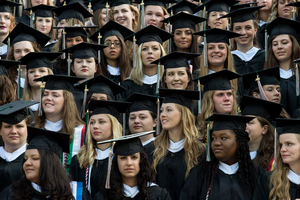Is a liberal-arts degree now less likely to lead to a well-paying job?
A recent analysis found the average liberal arts student is earning far less 10 years after college than most other university students.

Sweet Briar College graduates wait to have their official group photo taken by college staff before commencement exercises begin Saturday morning, May 16, 2015 outside of Amherst, Va. Sweet Briar is one of number of liberal arts colleges in the US which has struggled to keep its doors open.
Max Oden/AP
It’s official: Liberal-arts students earn way less after college than any other college graduate.
A new analysis by The Wall Street Journal found that, on average, students from the most selective liberal-arts colleges in the country earn around $50,000 10 years after graduation. In comparison, students who attended top universities and research institutes make at least $70,000. (One important qualifier: The research includes only includes graduates who are on some type of federal student aid.)
But the study raises interesting questions about the value of a liberal arts education at a time when prices at these elite private schools are skyrocketing. On average, an elite liberal-arts college costs between $50,000 - $59,000 a year. The College Board found that the cost of college rose by three percent last year, and across the board from private to public universities, raising concerns for a lot of families on the affordability of education.
At the same time, America's liberal-arts colleges haven’t been faring too well. Although the figures are subject to debate, it seems clear that the number of liberal-arts colleges in the US has actually shrunk a significant amount since the early '90s, when over 600 American colleges were considered to be liberal-arts schools. Now, by some counts, the number is closer to 200.
This doesn't necessarily mean that hundreds of schools have closed their doors but rather that many have changed their curricula in ways that may cause them to be categorized differently.
But the question remains: Will the liberal-arts education survive?
Defenders of the liberal arts are adamant that college rankings and post-college paychecks are only a small part of a much larger picture. Many argue that a liberal-arts education produces good “citizens” as opposed to graduating students more narrowly focused on finding well-paying jobs. In his book, “In Defense of a Liberal Education,” Fareed Zakaria argues that liberal-arts schools teach an “invaluable skill.”
“The central virtue of a liberal education is that it teaches you how to write, and writing makes you think. Whatever you do in life, the ability to write clearly, cleanly, and reasonably quickly will prove to be an invaluable skill.”
The concept of a liberal-arts college dates back to Thomas Jefferson, who founded the University of Virginia and believed that a well-rounded citizenry was the foundation of democracy. In an interview this summer, economist David W. Breneman told The New York Times that little has changed.
“If we lose an educated populace, we’re open for demagogy. We need broadly educated people,” Mr. Breneman said.
It's a concept that many outside the US find appealing as well. Ghana, for example, recently opened its first liberal-arts college and is working to extend the model to other parts of Africa.
But for cash-strapped families considering the options as they prepare to send their children to college, the new numbers on display in the WSJ article may be cause for concern.
“It might not tell us how every student from a college does,” Ben Miller, a senior director at the Center for American Progress, a left-leaning think tank, told the Journal. “But if I’m someone looking at getting a loan, I would probably want to know what I’ll make.”

